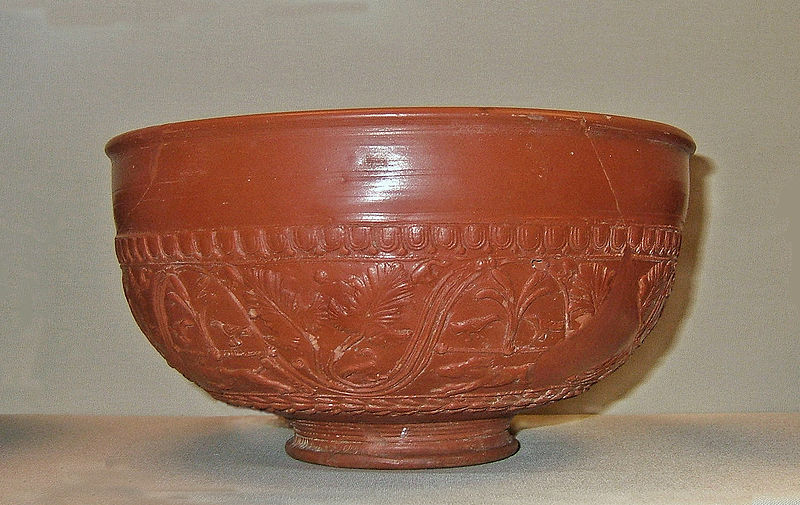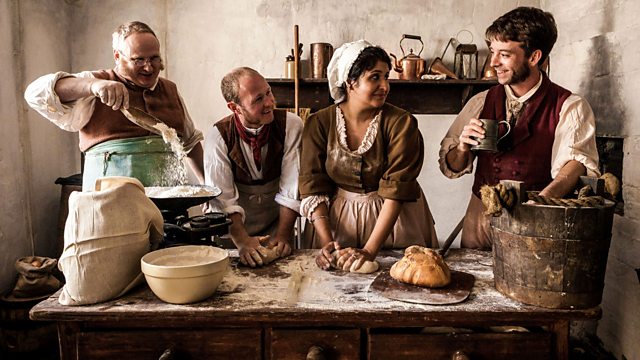Hello, Risky Readers, there’s been a slight change of plans and today you get me again. And I’m also rather late with posting – sorry about that! (I also apologize for any typos in this post; it’s really late here in Germany and I’m so ready to head to bed….)
So I thought today I could talk a little about food because tomorrow I will go to that lovely reconstructed Roman fort near where I live and attend a Roman cookery workshop. It’s called “A Look into Apicius’ Pots” and includes not just a guided tour through the fort and museum, but also a hands-on experience of Roman cuisine: we will prepare a meal using Roman recipes (from Apicius’ cook book, I assume) and then we’ll eat said meal from replicas of posh Roman tableware (that would be Samian ware made in what today is southern France).
There might even be garum, that dreadful, shudder-inducing Roman fish sauce that was made by putting fish heads and fish innards into a vessel together with herbs and what not and then putting it out into the sun for a couple of weeks. The Romans poured that stuff basically over everything. Like ketchup.
It’s going to be an interesting afternoon!
In addition to doing some practical research on Roman cuisine, I also recently stumbled across a rather fantastic BBC documentary called “Victorian Bakers.” In this documentary a group of modern-day bakers all don Victorian clothing and learn how their 19th-century predecessors made bread.
Bread was incredibly important for 19th-century England, as it was the staple food for large parts of the population. In the Regency period, bread making hadn’t yet become industrialized. Bakers ran their business as they had done for decades: from a bakery in a village, often near – or indeed, even part of – a local mill. They also worked closely with brewers from whom they got the yeast. Compared with more modern forms of yeast (think of dry yeast out of a package), this particular yeast was a bit more temperamental. The dough had to be kneaded much longer and the proofing took much longer as well. On the other hand, bakers had to be careful not to overproof the dough as it was possible the yeast would go bad.
Once the oven was fired up, the bread was baked and then the baker’s boy would go from house to house in the village and deliver bread that had been pre-ordered. As most people didn’t have an oven to bake in at home, bakers also offered a service whereby villagers could come and have their things baked in the baker’s oven.
While in earlier centuries only the upper classes had been able to afford white bread, by the early 19th century white bread had become the standard in all households. The older forms of barley bread and rye bread were disdained by large parts of the population, even though there were several attempts by health reformers to make whole-wheat bread popular again. Thus, in the Mirror of Literature, Amusement and Instruction we can read in 1847:
Nothing is more false to suppose than what is called fine white bread is better than the bread made of good wheat, ground into flour without abstricating from it the digestive principle contained in what is termed the husk, or skin. Nothing is more wholesome or so easy of digestion as this natural pure bread, when made with wheat of proper quality; and though the color is more homely, still the taste is far superior to that of white bread.
What I found perhaps most surprising about that BBC documentary was the realization that 19th-centiry bread would have tasted much, much different from our bread, mainly they used a different kind of wheat as well as that different yeast. That’s something we don’t really think about very often, do we?
And now it’s over to you: What type of historical food would you love to try and recreate?



Fascinating! I remember touring around England and seeing the kitchen in the townhouses and manor houses and all the silverware and such. But also getting to recreated plastic molds of “real” food during the Georgian time and such. The fruit cakes and pudding were interesting, but sugar was a huge thing and seeing the actual cone chunk of the hard sugar was mind boggling. What food I want to make? The desserts of course! But meat and mutton pies are one thing I definitely want to know how to make since I actually like them, so seeing how they’re made back then would be amazing. And it’ll definitely taste different too.
I would LOVE to try mutton pie! Some chance here. My husband and kids are very picky food wise whereas I’d eat anything. Historical food to try: I wouldn’t go back that far as I would love to eat the currant bread my Mother used to make when we were kids. She can’t give me a recipe as she always just guessed amounts and I can’t bake like that. I remember it warm from the oven with butter melting into it. Memories of childhood!! Good days.
Fascinating post, Sandra. I would dearly love to taste the bread baked during the Regency if for no other reason than to compare it to bread today. I prefer pumpernickel bread to any other, in spite of the fact I cannot find any to compare to the pumpernickel I had in Germany.